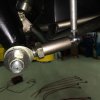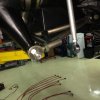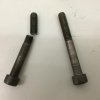The Mystery:
During the last couple of sessions at TWS if I accelerated hard the GT would pull to the left. But with aggressive driving it seemed to do fine. Could not figure out what was going on.
Well I found it Saturday by accident which probably saved an accident in the future.
This is a weak link that I noted when taking the car apart and reassembling it after I got it some years ago but didn’t do anything about it.
It has to do with the way that the rear sway bar link connects to the lower control arm of the rear suspension. The part that I didn’t like is that the same 8mm cap screw that connects the link to the lower control arm spherical joint is also the same 8mm bolt that keep the spherical joint in place. The joint does not screw into the lower arm but is held in place by this 8mm cap screw. Granted this allows for easy suspension adjustment but it places a lot of odd loads on this small cap screw.
The cap screw had sheared right where it screws into the end of the joint. Because it was so long it stayed in place and actually still allowed it to do it intended job of transferring sway bar loads to the suspension. What it couldn’t do is keep the lower joint from sliding in and out of the lower control arm sleeve under hard acceleration. What is weird is that it stayed in place so long. I was simply cleaning the road grime off the suspension and hit the sway bar link with my arm the cap screw and link fell off. I could grab the bottom of the upright and move it in and out of the sleeve by hand. So under hard acceleration the joint was sliding out of the sleeve causing the left rear wheel to go excessive toe in. When power was removed it would slide back in and all was good again.
This is my fault for not replacing these low grade cap screws with better bolts as I had done with all of the other suspension bolts that I had replaced with air frame bolts. I would suggest that you replace this before any possible drama happens. There are some quality ARP blots on their way to me.
During the last couple of sessions at TWS if I accelerated hard the GT would pull to the left. But with aggressive driving it seemed to do fine. Could not figure out what was going on.
Well I found it Saturday by accident which probably saved an accident in the future.
This is a weak link that I noted when taking the car apart and reassembling it after I got it some years ago but didn’t do anything about it.
It has to do with the way that the rear sway bar link connects to the lower control arm of the rear suspension. The part that I didn’t like is that the same 8mm cap screw that connects the link to the lower control arm spherical joint is also the same 8mm bolt that keep the spherical joint in place. The joint does not screw into the lower arm but is held in place by this 8mm cap screw. Granted this allows for easy suspension adjustment but it places a lot of odd loads on this small cap screw.
The cap screw had sheared right where it screws into the end of the joint. Because it was so long it stayed in place and actually still allowed it to do it intended job of transferring sway bar loads to the suspension. What it couldn’t do is keep the lower joint from sliding in and out of the lower control arm sleeve under hard acceleration. What is weird is that it stayed in place so long. I was simply cleaning the road grime off the suspension and hit the sway bar link with my arm the cap screw and link fell off. I could grab the bottom of the upright and move it in and out of the sleeve by hand. So under hard acceleration the joint was sliding out of the sleeve causing the left rear wheel to go excessive toe in. When power was removed it would slide back in and all was good again.
This is my fault for not replacing these low grade cap screws with better bolts as I had done with all of the other suspension bolts that I had replaced with air frame bolts. I would suggest that you replace this before any possible drama happens. There are some quality ARP blots on their way to me.





